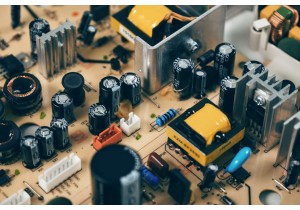Equivalent Series Resistance (ESR) directly impacts the performance of capacitors in high-frequency circuits, such as 5G devices, IoT sensors, and electric vehicle inverters. Ignoring ESR can lead to overheating, signal distortion, or even circuit failure. This article explains why ESR matters, how to choose the right capacitors, and industry trends shaping component selection.
What Is ESR?
ESR measures the internal resistance of a capacitor, acting like an invisible resistor in series with the component. This resistance causes energy loss as heat during operation. For example, in a smartphone’s 5G antenna circuit, a capacitor with high ESR will waste battery power and generate excess heat, reducing signal clarity.
Why ESR Matters in High-Frequency Circuits
High-frequency circuits (operating above 1 MHz) are sensitive to even small ESR values. Three key effects of high ESR include:
-
Power Loss: Energy dissipates as heat, lowering efficiency. A Wi-Fi 6 router’s RF amplifier with high-ESR capacitors may overheat, causing signal drops.
-
Signal Noise: Residual resistance disrupts clean voltage delivery. In a drone’s GPS module, this can lead to positioning errors.
-
Reduced Lifespan: Heat from ESR accelerates component aging. A server’s CPU power supply using high-ESR capacitors may fail within months.
Industry Trends Driving Low-ESR Demand
-
5G Expansion: Base stations and smartphones require capacitors with ESR below 0.05Ω for stable millimeter-wave signal processing.
-
Electric Vehicles (EVs): Inverters and onboard chargers use 100+ capacitors with ultra-low ESR (<0.01Ω) to handle rapid switching frequencies.
-
Miniaturization: Smaller devices like wearables need compact, low-ESR MLCCs (multilayer ceramic capacitors) to save space and power.
Capacitor Types: ESR Comparison
-
MLCCs: Lowest ESR (0.001–0.1Ω), ideal for decoupling in CPUs. For example, a gaming laptop’s GPU uses MLCCs to filter high-frequency noise.
-
Tantalum Capacitors: Moderate ESR (0.05–0.5Ω), used in power supply filtering for medical devices.
-
Aluminum Electrolytic: Highest ESR (1–10Ω), suited for low-frequency applications like LED lighting drivers.
How to Select Low-ESR Capacitors
1. Check Datasheet ESR Curves
ESR varies with frequency and temperature. A capacitor rated 0.02Ω at 100 kHz might jump to 0.1Ω at 1 MHz. Use manufacturer graphs to verify values.
2. Prioritize MLCCs for Frequencies >1 MHz
A 5G smartphone’s power management IC (PMIC) uses MLCCs with ESR <0.01Ω to handle 2.4 GHz signals. Avoid aluminum capacitors here—they’re too slow.
3. Consider Polymer Capacitors for High Ripple Current
In EV charging stations, polymer capacitors offer ESR as low as 0.005Ω while handling high current surges.
4. Avoid Overheating with Thermal Analysis
Simulate heat buildup using tools like Ansys Q3D. A server motherboard capacitor operating at 85°C may see ESR double, risking failure.
Common ESR-Related Mistakes
-
Ignoring Frequency Dependence: Assuming ESR is constant across frequencies. A 0.02Ω MLCC at 10 kHz might perform poorly in a 100 MHz radar system.
-
Overlooking Temperature Effects: ESR rises with heat. A solar inverter capacitor rated for 25°C may fail in a 60°C desert environment.
-
Mixing Capacitor Types Incorrectly: Pairing a high-ESR tantalum capacitor with an MLCC in a noise filter can cancel their benefits.
Tools for ESR Data Integration
-
Supplier Websites: TDK, Murata, and KEMET provide searchable databases with ESR vs. frequency charts.
-
Simulation Software: LTspice or Keysight ADS models predict ESR impact on circuit stability.
-
Cross-Reference Platforms: Octopart or Findchips compare ESR ratings across brands for equivalent parts.
Future Trends in Low-ESR Capacitors
-
Silicon-Carbon MLCCs: New materials aim to reduce ESR by 30% for 6G telecom systems.
-
Integrated Passive Devices (IPDs): Embedding capacitors into chips minimizes ESR losses in space-constrained designs.
-
Automated Testing: AI-driven quality control ensures tighter ESR tolerances for aerospace and medical devices.
Selecting capacitors with the right ESR is critical for high-frequency circuit reliability. Prioritize MLCCs or polymer capacitors for frequencies above 1 MHz, validate ESR under real operating conditions, and leverage simulation tools to avoid design flaws. As 5G, EVs, and IoT advance, understanding ESR will remain essential for optimizing performance and longevity.

